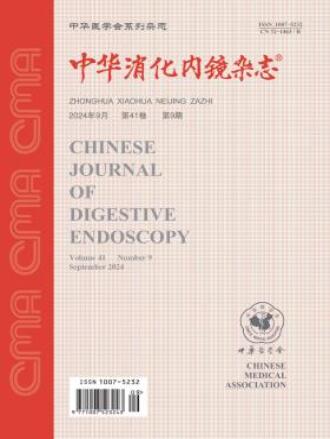内镜下处理消化道瘘的临床研究
引用次数: 1
摘要
目的探讨内镜下空肠置管、内镜夹持、镜下夹持治疗消化道瘘的价值。方法回顾性分析2015年7月至2017年7月苏州大学第一附属医院收治的38例消化道瘘患者的资料。根据瘘管的大小和位置选择治疗方法。13例患者放置空肠管(空肠管组),20例患者行内镜夹持(内镜夹持组),5例患者行OTSC(OTSC组)。分析技术成功率、临床治愈率及术后住院时间。结果所有患者手术成功,无明显并发症。空肠管组4例患者瘘管完全愈合,3例患者治疗后病变缩小,5例患者病变无变化,1例死亡。全治愈率30.8%(4/13),术后住院时间47.4±14.1 d。内镜夹持组16例患者瘘管完全愈合,3例病变不小于治疗前,1例死亡。完全治愈率为80.0%(16/20),术后住院时间17.9±8.9 d。OTSC组全部患者完全治愈,完全治愈率为100.0%(5/5)。1例难治性食管瘘患者在内镜夹持下多次行OTSC,瘘口愈合时间为102天。4例患者术后住院时间为5.3±1.7 d。与夹持组和空肠管组相比,OTSC组瘘管治愈率更高(P=0.03, P<0.001),术后住院时间更短(P=0.04, P<0.001)。结论内镜下治疗消化道瘘安全有效,创伤小,操作简便,愈合时间短。关键词:消化系统瘘;内镜治疗;空肠管放置;内窥镜剪裁;在瞄准镜夹上本文章由计算机程序翻译,如有差异,请以英文原文为准。
Clinical research in the endoscopic management of digestive fistula
Objective
To evaluate the therapeutic value of endoscopic jejunal tube placement, endoscopic clipping, and over the scope clip (OTSC) for digestive fistula.
Methods
Data of 38 patients with digestive fistulas at the First Affiliated Hospital of Soochow University admitted from July 2015 to July 2017 were retrospectively analyzed. Treatments were chosen according to the size and the site of the fistulas. Thirteen patients underwent jejunal tube placement (the jejunal tube group), 20 underwent endoscopic clipping(the endoscopic clipping group), and 5 underwent OTSC(the OTSC group). The technical success rate, clinical cure rate and postoperative hospital stay were analyzed.
Results
All patients received the endoscopic operation successfully with no significant complications. In the jejunal tube group, 4 patients′ fistulas fully healed, lesion was smaller after treatment in 3 patients, lesion didn′t change in 5 patients, and 1 patient died. The complete cure rate was 30.8% (4/13), and the postoperative hospital stay was 47.4±14.1 days. For the endoscopic clipping group, 16 patients′ fistulas fully healed, lesion was no smaller compared with that before treatment in 3 cases, and 1 patient died. The complete cure rate was 80.0% (16/20), and the postoperative hospital stay was 17.9±8.9 days. Total patients in the OTSC group were completely cured, with 100.0%(5/5) of complete cure rate. One patient with refractory esophageal fistula underwent OTSC repeatedly with endoscopic clipping, and the healing time of fistula was 102 days. The postoperative hospital stay of 4 others was 5.3±1.7 days. The cure rate of fistula was higher (P=0.03, P<0.001) and the postoperative hospital stay was shorter (P=0.04, P<0.001) in the OTSC group compared with the clipping group and the jejunal tube group.
Conclusion
Endoscopic management is safe and effective for digestive fistulas with less trauma, easy performance and short time of healing.
Key words:
Digestive system fistula; Endoscopic therapy; Jejunal tube placement; Endoscopic clipping; Over the scope clip
求助全文
通过发布文献求助,成功后即可免费获取论文全文。
去求助
来源期刊
CiteScore
0.10
自引率
0.00%
发文量
7555
期刊介绍:
Chinese Journal of Digestive Endoscopy is a high-level medical academic journal specializing in digestive endoscopy, which was renamed Chinese Journal of Digestive Endoscopy in August 1996 from Endoscopy.
Chinese Journal of Digestive Endoscopy mainly reports the leading scientific research results of esophagoscopy, gastroscopy, duodenoscopy, choledochoscopy, laparoscopy, colorectoscopy, small enteroscopy, sigmoidoscopy, etc. and the progress of their equipments and technologies at home and abroad, as well as the clinical diagnosis and treatment experience.
The main columns are: treatises, abstracts of treatises, clinical reports, technical exchanges, special case reports and endoscopic complications.
The target readers are digestive system diseases and digestive endoscopy workers who are engaged in medical treatment, teaching and scientific research.
Chinese Journal of Digestive Endoscopy has been indexed by ISTIC, PKU, CSAD, WPRIM.

 求助内容:
求助内容: 应助结果提醒方式:
应助结果提醒方式:


